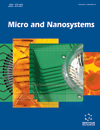- Home
- A-Z Publications
- Micro and Nanosystems
- Previous Issues
- Volume 2, Issue 1, 2010
Micro and Nanosystems - Volume 2, Issue 1, 2010
Volume 2, Issue 1, 2010
-
-
Printed Organic Electronic Technology Platform Enabling the Design and Manufacturing of Integrated Circuits Towards Plastic Microprocessors
More LessAuthors: L. G. Occhipinti, M. La Rosa, N. Malagnino, A. Marcellino, D. Nicolosi, F. Porro, G. Sicurella, R. Vecchione, V. Vinciguerra and M.V. VolpeA dedicated printed electronics technology platform has been developed and implemented. The technology is devoted to the manufacturing of all-organic transistor devices with sub-micron feature size as multilayered structures, obtained through a sequential combination of deposition from solution and patterning steps through stamps. The manufacturing process includes fabrication of both rigid and flexible elastomeric sta Read More
-
-
-
CNTs - A Comparable Study of CNT-Filled Adhesives with Common Materials
More LessAuthors: Heimann Matthias, Bjoern Boehme, Scheffler, Sebastian, Martin Wirts-Ruetters and Klaus-Juergen WolterElectronics packaging must be designed to meet the increasing requirements of the microelectronics industry. Future packages will have an even higher number of I/O's and pitches down to 20 microns resulting in high dissipation losses and extreme current densities. When using conventional materials, design engineers will face physical barriers and limitations in performance and new material solutions have to be found. Relia Read More
-
-
-
Design and Analysis of a Dual-Mode MEMS Micromirror
More LessAuthors: Xingguo Xiong, Tim Dallas, Shubhra Gangopadhyay, Jordan Berg and Temkin HenrykIn this paper, the design and simulation of a dual-mode Aluminum MEMS micromirror device are proposed. The dual-mode micromirror can work in either torsional or piston modes, depending on the voltage scheme applied to the bottom driving electrodes. The working principle and performance of the micromirror are analyzed. Based upon the analysis, a set of optimized micromirror design parameters is suggested, Read More
-
-
-
Nanorobotic Strategy for Nondestructive Mechanical Characterization of Carbon Nanotubes
More LessAuthors: V. Eichhorn, M. Bartenwerfer and S. FatikowThe characterization of individual nanoscale objects such as carbon nanotubes (CNTs) is one of the main challenges in material science and nanotechnology. In this paper, we present a nanorobotic strategy allowing the nondestructive mechanical characterization of individual CNTs. A nanorobotic setup is developed to perform elastic deformations of multiwalled carbon nanotubes (MWCNTs). Characteristic force/displac Read More
-
-
-
Effects of Double-Walled and Multi-Walled Carbon Nanotubes on Primary Immune Cells In Vitro
More LessAuthors: Zhang Jinchao, Peng Xiaomin, Li Luwei, Sun Jing, Zheng Yanju and Shen ShigangThe effects of DWCNTs and MWCNTs on primary immune cells in vitro were studied at cell level. The results indicated that DWCNTs (1, 10, 25, and 50μg/mL) promoted the proliferation of the spleen cells. MWCNTs had no significant effect on the proliferation of the spleen cells at concentrations of 1, 10, and 10μg/mL, but promoted the proliferation at concentration of 25μg/mL. DWCNTs (1, 10 25, and 50μg/mL) promoted the proli Read More
-
-
-
Sensitivity Deviation Probability Model of Close Loop Micro- Accelerometer Based on Comb Finger Gaps' MEMS Process Error
More LessAuthors: Qiang Dai, Yu Qi, Zhong Zhiyong, Zhou Wei and Zhang HuaiwuA sensitivity deviation probability model is proposed, for the first time, to describe the sensitivity deviation probability of micro-accelerometer brought by the MEMS process error in comb finger gaps. The sensitivity model is set up following the capacitance probability model on the premise that the error is in an interval with equal probability. It's indicated that, by the model, the probabilities for two kinds of deviation, decreas Read More
-
-
-
The Study on Wettability of Super-Hydrophobic Composite Coatings Preparation by Surface Gelation Technology
More LessThe fluoropolymer/silicon sol composites were fabricated via conventional materials by using surface gelation technology; the hydrophobic models in the surfaces of the composite coatings were discussed. The wetting behavior of the composite coating surface exhibited Wenzel model when the surface's roughness was low enough, and Cassie model was available when roughness was high enough. It was assumed that the hierar Read More
-
Most Read This Month
Article
content/journals/mns
Journal
10
5
false
en


